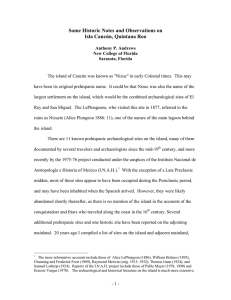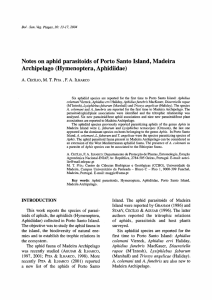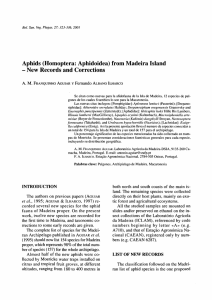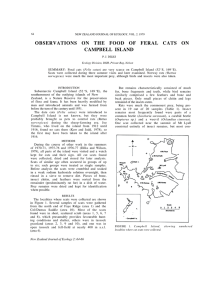economically dependent
Anuncio
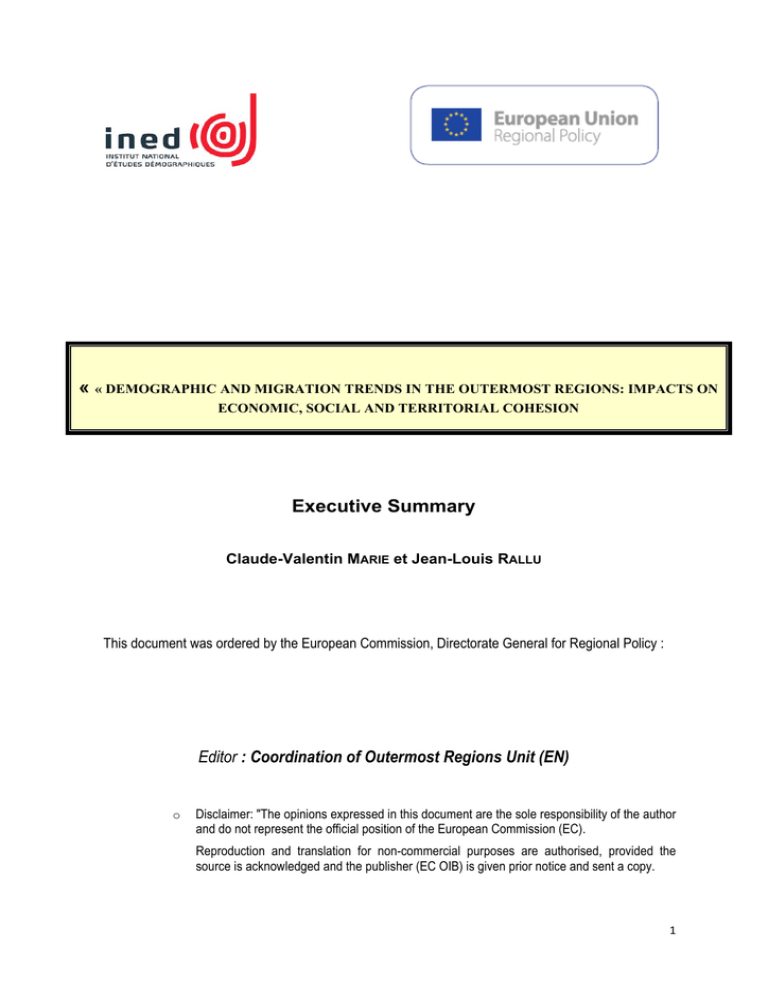
« « DEMOGRAPHIC AND MIGRATION TRENDS IN THE OUTERMOST REGIONS: IMPACTS ON ECONOMIC, SOCIAL AND TERRITORIAL COHESION Executive Summary Claude-Valentin MARIE et Jean-Louis RALLU This document was ordered by the European Commission, Directorate General for Regional Policy : Editor : Coordination of Outermost Regions Unit (EN) o Disclaimer: "The opinions expressed in this document are the sole responsibility of the author and do not represent the official position of the European Commission (EC). Reproduction and translation for non-commercial purposes are authorised, provided the source is acknowledged and the publisher (EC OIB) is given prior notice and sent a copy. 1 2 1. Recent trends Demography The Outermost Regions of the European Community (OR), their locations extending to either side of the Atlantic and as far as South America and the Indian Ocean do not form an identifiable group. Despite displaying similar characteristics, the regions share more with the country to which they are attached. This is particularly the case of fertility and natural growth. As regards the latter, Portugal and Madeira lie below the EU average and the level is only higher than this average in the Azores, the Canary Islands and Spain because of an age structure favourable to natural growth. In contrast, natural growth in France and the DOM is higher than the UE average because of higher fertility levels. Fertility trends in Reunion Island and particularly in St Martin and French Guiana present a challenge for years to come. The total growth rate in Reunion Island is 1.5%, against 0.5% on average in the OR, whilst in St Martin, it is close to 3% and in French Guiana, it surpasses this rate. In parallel to the mainland, the Spanish and Portuguese OR have become immigration destinations after having been predominantly characterized by emigration. The impact of immigration in the Canaries was stronger than in mainland Spain during the first half of the 2000s and was much less strong in the Azores and Madeira than in Portugal. However, the Canary Islands and Madeira play a significant role in receiving retired migrants from Northern Europe and North America. It must be noted that the economic crisis deeply affected migration to Spain, Portugal and their OR. Meanwhile, the French Antilles (Martinique and Guadeloupe) and Reunion Island receive only moderate number of international migrants, in contrast to French Guiana, and periodically St Martin, where the crisis has so far relatively little affected large immigration. The flows of irregular migration, which have particularly affected French Guiana, the Canary Islands and Guadeloupe (when St Martin was still administratively part of the region) had considerably decreased before the crisis and are currently low scale in Canaries. In French Guiana, St Martin (and, to a lesser extent, Guadeloupe), irregular migration seems less dependent on the economic climate and continues at a significant level. As regards ORs’ ‘internal’ migration within countries or the EU, the DOMs experience much higher ‘pendular’ migration with their mainland metropolises than the other ORs with their country. Natives to the DOM and people born in mainland France move in both directions within these flows.1 However, numbers of EU migrants, mostly retirees from Northern EU states, are higher in East Atlantic ORs. Generally, the migration balance is slightly negative in the French Antilles due to the large number of departures of Antillean‐born people. Arrivals balance departures in Reunion Island, but the balance is highly positive in St Martin and French Guiana because of the numbers of foreign immigrants. The balance is slightly positive in Azores and Madeira and it has recently witnessed a steep decline in the Canaries. 1 A proportion of the mainland French born people arrive in the DOM with short‐term contracts so there is a constant turnover, with about a third of mainlanders residing in DOM having arrived in the last 5 years. 3 These migratory flows, particularly the departures of young DOM‐born and the arrivals of mainland French aged 30‐45, have a strong effect on the shape of the age pyramids of the French Antilles and to a lesser extent, that of Reunion Island and French Guiana. In French Guiana and St Martin (and previously, the Canaries), foreign immigration, the most significant, raises the weight of adults aged 20‐60 years. These migrations combined with a higher natural growth explain the younger age structures in the OR in comparison with those of the mainland states of which they are a part. Even if this advantage is declining, the dependency ratio is still more favourable in the Eastern Atlantic OR compared to the mainland states. In the case of the French Antilles and Reunion Island, the dependency ratios are close to those of continental France, but in French Guiana, the ratio is higher owing to the high proportion of young people. Compared to the UE dependency ratio, Canaries, Madeira and Azores have advantages of respectively 7, 6 and 5 percentage points, whilst Martinique, Reunion Island and St Martin have advantages by 1 or 2 points. On the other side, Guadeloupe has a disadvantage of 0.8 point, whereas it reaches 10 points for French Guiana. Ageing is one of the major problems facing the French Antilles and the Eastern Atlantic OR. The process has been underway for a number of decades and has recently been particularly rapid in the French Antilles. The median age has risen by ten years since 1990 in the Antilles and the Canaries, by 6‐7 years in the Azores, Madeira and Reunion Island, but has remained stable in French Guiana (+1 year). In contrast, the main challenge facing French Guiana and St Martin is population growth. Meanwhile Reunion Island faces both ageing and population growth, but at more moderate levels. These population dynamics, and the structural changes they incur, have important consequences in several socio‐economic domains: increasing needs in education services and job creations for populations experiencing rapid growth in the numbers of young people; the possible drop in the economically active population and rises in health costs for ageing population. Education In socio‐economic terms, the Eastern Atlantic OR appear more similar to the continent than the DOM to mainland France. There are still stark contrasts in terms of skill levels, despite the OR having see improvement in examination success rates, and relatively few young people pass the final exam at he end of secondary education. In comparison to the continent, a far higher proportion of young people do not complete their secondary education. Illiteracy, failure or school drop out2 reflect a relative inadequacy of the education system, both in quantitative and qualitative terms. However, the intergenerational reproduction of poverty has an impact on the cultural environment and thus on the relationship to education. In French Guiana, the Canary Islands and St Martin many school‐age children do not attend school. The average proportion is around 3%, higher amongst the native populations and even higher amongst foreign immigrants. The situation of the latter is exacerbated by linguistic difficulties and cultural factors. Yet this is only the tip of the iceberg, since 12‐17% of 15‐24 year‐olds in the French Antilles and Reunion Island are illiterate. 2 Actually ‘leaving education prematurely’, meaning to drop out after passing the exam of compulsory education or to quit studies with a lowest diploma. 4 School failure rates are higher in the OR, particularly in the DOM where they are generally twice as high as the national average. This rate is about 15% amongst 18‐24 year‐olds in the Canaries and the French Antilles, 23% in Reunion Island, 29% in Madeira and as high as 39% in the Azores and French Guiana. Leaving the school system prematurely3 is related to specific factors. In the DOM, young people who have obtained the BEPC exam4 for the first stage of secondary education usually stay at school because of the difficulties in finding employment corresponding to this education certificate. In the Canaries, Madeira and the Azores, where access to employment (at least prior to the crisis) is higher, people leaving school after receiving the certificate at the end compulsory education5 are more numerous: 37%, 20% and 14% respectively, compared with 5% in the DOM. Education after the official school leaving age in the DOM is provided at levels CITE3 and CITE4, the subsequent levels being principally available in continental France. The Canary Islands, and to a lesser extent the French Antilles and Reunion Island, which have the most important universities have the highest rates of students at levels CITE5 and CITE6; 45%, 35% et 29% respectively. The rates are particularly low in Azores and Madeira (under 20%) and in French Guiana (15%). Education and the acquisition of skills remain severe problems in the OR. Despite the immigration of skilled people from the continent or from other parts of the EU, the proportion of young adults (30‐ 34) with higher education diplomas is lower than in the mainland states, partly owing to the sizeable emigration of educated native‐born. Thus more than half the DOM‐born with tertiary level education in this age group live and work in continental France. The proportion of tertiary educated people of this age group is highest in the Canaries, Martinique, Guadeloupe and Reunion Island and lowest in French Guiana and particularly low in the Azores and Madeira. Migration therefore has a highly selective influence on the skill levels of the working population in the OR. Half the most skilled leave the DOM whereas a majority of young people with few skills and less potential for finding employment remain in the region. This double selective process partly explains the high level of unemployment, the social exclusion of a high proportion of young people and the continued need for training. Employment The low education level of a sizeable section of the OR populations has repercussions on their opportunities within the labour market. In turn, this has an impact on the economic development of these regions. The situation has become worse since the 2008 crisis. Whilst employment levels remain higher in the Azores and Madeira than in Portugal or than the EU average, the same cannot be said for the Canaries in relation to Spain. Here, the economic crisis set off a fall in employment for all age groups in 2008 that further increased in 2009 and has not yet stabilized in 2010. By comparison, employment in the DOM, which was already at a lower level prior to the crisis, was little affected until 2010, but unemployment rates increased in 2008‐2010 (except for Martinique in 2010). As a result, unemployment levels in the Canaries are almost at the level of those in the DOM, with rates of about 50% amongst the young active population. Despite a recent increase, unemployment remains at moderate levels in Azores and Madeira. 3 Before the end of secondary education, that is at the official school leaving age. The BEPC is the exam taken after the first four years of secondary education, at approximately, or just before, the official school‐leaving age of 16. 5 Lower secondary in Canaries and France, primary education in Portugal. 4 5 In 2010, apart from the Azores and Madeira, employment rates amongst the economically active population (20‐64) were much lower than the EU average (which was 69% prior to the crisis). The rates are about 55% in the Canary Islands, the French Antilles and French Guiana, and 50% in Reunion Island. The differences in employment rates between men and women show that it is possible to increase female employment. The deficit in female employment rates is particularly strong in French Guiana, the Azores, Reunion Island and the Canaries. Clearly reducing unemployment and the exclusion of young people from the labour market would be a means to increasing employment levels. It is twice more frequent to be ‘young and out of work’ (18‐24, neither a student nor in work) in the DOM than in the Eastern Atlantic OR. This is despite a number of state‐ or ESF‐funded programmes aiming to improve training and employment levels, some of which have been reasonably successful. The take‐up levels on some training schemes are fairly high, but return to unemployment is often swift and frequent. Furthermore, the number of beneficiaries of these schemes remains lower in the DOM than in continental France, despite unemployment being higher in the French OR. Integrating young people into the labour market not only reduces unemployment levels but, above all, improves their personal social status and prevents them from falling further into social exclusion and violence. Employment structure in the OR, with its heavy reliance on the service sector, does not provide many openings for less‐skilled people. The service sector generates on average over 80% of jobs, but a slightly lower proportion in Madeira (70%) and in the Azores (63%). The numbers employed in agriculture represent 11% of the employed in Azores and Madeira, but count for less than 5% in the other OR. The industrial sector plays a much smaller role in OR than on the continent; and, although the building sector is higher, particularly in the Eastern Atlantic OR, it does not compensate for the weakness of the industry. The lower employment rates in the DOM are mainly caused by the low education levels of the native‐ born and of foreign migrants. However, there are no significant differences in employment rates according to birthplace for those with higher secondary certificate (“baccalauréat”) or higher education qualifications. The narrow and isolated labour market in the DOM meaning that the least skilled are trapped, unable to move to another region to find work at their level of qualifications; that is, other than moving to continental France, where the selection is increasingly harsh. On the contrary, those born in mainland France or elsewhere in the EU seem to have an advantage over the other recent migrants, including return migrants (principally for men). A certain proportion of these migrants arrive with a work contract. Between 1999 and 2007, migrants born in mainland France occupied 20% of jobs created in the French Antilles and Reunion Island. Moreover, they occupy more highly skilled jobs or have greater responsibilities than native DOM‐born with the same qualifications. This is one of the reasons for the brain drain from these regions. However, women seem not to benefit from improved access to employment as do men. . What is at stake here is the future increase of effective dependency ratios, the burden falling on the actively occupied population. In the DOM, where unemployment is high, as is the proportion of working age people not in the labour market, the ratio is two economically dependent people to one in work in Martinique, 2.2 in Guadeloupe, 2.5 in Reunion Island and 2.8 in French Guiana, compared with 1.4 in mainland France. In the Eastern Atlantic OR, the ratio is 1.6 in the Canary Islands, 1.2‐ 1.3 in Madeira and in the Azores, that is, little over the ratio on the continent (1.5 in Spain, 1.2 in 6 Portugal). In a context in which social policy is decreasingly funded by central state, this responsibility being transferred to the regions, such dependency ratios constitute a direct threat to the funding of social policies in the OR. The economy Up until 2000‐2001, the GDP per inhabitant in the OR grew rapidly, with average rates of around 6% and as high as 8% in the Azores and 11% in Madeira. French Guiana has been an exception, with far lower rates, not owing to lower economic growth but to faster population growth than in the other OR. Economic growth slowed in all the regions after 2002, leveling off at around 4% annually until 2007 (but at 6.6% in Madeira). This growth, higher than in mainland states, reduced the gap between OR and the continent. However, only Madeira surpassed the EU average, whilst the GDP remained lower by 8% in the Canary Islands, by around 25% in the Azores and Martinique, 30% in Guadeloupe, 37% in Reunion Island and as much as 50% in French Guiana. From 2008 onwards, the crisis reversed the trend, except in the Azores and Madeira, and the difference between the EU and the OR started to increase again. Note that the calculation of the GDP PPP6 at the national level does not take into account the higher cost of living in the OR than on the continent, particularly the case in the DOM. Thus, in reality, the differences are greater than those indicated above. Except in the case of Madeira, productivity is lower in the OR by comparison to the their mainland to, , . This is especially so in the DOM. Clearly economic convergence towards the EU averages is far from being achieved, apart from in Madeira, and is being further hampered by the financial and economic crisis. The economies of the OR are focused on the service sector, which represent over 80% of added values. In French Guiana and the Azores, this is slightly lower, at 75%. Whilst tourism plays an important role in the economies of Madeira and the Canary Islands, with a rate of 4 tourists per inhabitant per year, the sector is little developed yet in the other OR. Only St Martin differs, with 20 tourists per inhabitant, owing to the high numbers of cruise ship tourists. In contrast to their low share in added value, agriculture and the food industry are the primary export sectors in the OR. They account for 50% of exports on average, 70% for the Azores and Reunion Island, but only 15% for the Canaries. The low added value of these exports means that they cannot counterbalance imports. There is a deficit in trade balance in all the OR, with coverage rates scarcely above 50% in the Azores and Madeira, 22% in the Canary Islands and 10% or less in the DOM. Exports are principally directed to the continent (their national mainland or elsewhere in the EU) and the proportion directed to neighbouring states remains minimal owing to the fact that these are usually developing countries. 6 Purchasing power parity 7 Households and housing Growth in the number of households has been greater than that of the overall population. This growth is linked to ageing and to the numbers of young people leaving the parental home. The result is a decrease in household size. Whilst economic growth over the last two decades has helped to reduce the quantity of poor housing in the OR, there still remains a substantial proportion of dwellings that are lacking in the basic utilities (electricity, running water, sewage disposal). This is particularly the case in French Guiana, where such dwelling types account for 25% ‐ and insalubrious housing is estimated at 13% ‐ of the housing stock. The proportion of social housing units in Canaries is far below that of Spain, but it is rather similar in the DOM and in mainland France. However, the demand from eligible households is higher, owing to greater levels of poverty. Thus entitlements to public housing outweigh available stock. This is for example the case for single parent families, more frequent in the French Antilles and French Guiana (where these represent about 45% of families with children) and in Reunion Island (33%) than on the continent (22%). Similarly, single parent families are more common in the Canary Islands and Madeira than on the continent (28% and 19% respectively in comparison to 20% in Spain and 15% in Portugal); in the Azores, they only represent one in ten households. Many such households experience difficult living conditions. Less than half single mothers in the DOM, the Azores and Madeira are in paid work and only 32% in Reunion Island. These households are proportionately more reliant on social assistance than others. Such living conditions have repercussions on children’s education and often lead to intergenerational reproduction of social exclusion. Health With the exemption of Martinique, life expectancy at birth is less in the OR than on the continent. Life expectancy is much lower in French Guiana and Reunion Island and in the Azores and Madeira. Infant and maternal mortality rates are also higher in the DOM than in mainland France. Certain causes of death play a major role. Mortality caused by cardiovascular diseases is far higher in the Azores, Madeira and Reunion Island than on the continent. Similarly, the rates for respiratory diseases and diseases of the digestive tract are also higher in these regions and for tumours, apart from the DOM. Endocrinal and metabolic diseases are a major problem, the rates of mortality as a result of these diseases being at least twice as high in all the OR as on the continent. These findings are a cause for concern, since cardiovascular and endocrinal diseases are chronic diseases, linked to life style and environment. Furthermore, the cost to the health system is high and preventative health measures are in their early stages in the OR. In the DOM, the extension of these ‘lifestyle diseases’ is taking place in parallel to the continuing prevalence of infectious diseases, notably in French Guiana where climatic factors increase the risk of such diseases. There are a number of other specific health issues in the OR. Whilst the Eastern Atlantic OR and Reunion Island are less affected than the continent by the HIV virus, the French Antilles, and French Guiana and St Martin especially, have high rates of HIV infection. Migrant groups are particularly affected. Yet rates in these regions are much lower than in some of the Caribbean states. Alcoholism is more often a cause of mortality in OR than in the countries to which they are attached, notably in the DOM, and especially in Reunion; however, it remains a minor cause of death in the 8 Canaries. Similarly, in the French Caribbean OR (French Antilles and French Guiana), traffic accidents are a higher cause of mortality than on the mainland, but this is not so for the Canaries and Madeira. Part of the excess mortality in the OR can be attributed to the lower education levels. In the DOM, unemployment and social exclusion combine with this, as people delay consulting a doctor until their illness is at an advanced stage. This is particularly the case for the geographically isolated populations in the French Guyanese interior. All the OR populations would benefit from wider information campaigns on lifestyle diseases and risk behaviours. Excess mortality can also be linked to lower health resources than on the continent, that is, medical staff, hospital beds, nurses, and so on. Only the Eastern Atlantic regions have similar health resources to those on the continent as regards hospital beds, as well as for the numbers of nurses per inhabitant in the Portuguese OR. The situation is worse in the DOM. In general, the number of doctors, particularly specialists, and surgical hospital beds is lower than the mainland France average. French Guiana especially suffers from a shortage of resources, rates often being over half less the average for France. Demographic growth means that it will be difficult to catch up with the national level. Furthermore, medium and long‐stay beds are less numerous in the DOM, necessitating frequent and costly transfers of patients to mainland France. The Canary Islands and Madeira populations are in this respect far better provided for. Environment – energy The Island environments are fragile. Their limited size means that large areas of their territory and coastlines rapidly can become polluted. Environmental protection, including that of sea life, is required so that the population can enjoy a healthy habitat, the biodiversity be maintained and so that the OR can be attractive tourist destinations. All this necessitates greater efforts towards sustainable agricultural practices, sewage treatment and disposal of household and industrial waste. Energy consumption (fuel and electricity) per inhabitant has rapidly grown in the OR during the last two decades owing to the ‘catching up’ process as households have become equipped with electrical appliances, vehicles and so on. Economic growth in general has contributed to this. Growth has slowed since 2000 but remains higher than the level of demographic growth, at a rate of 2‐3% since mid‐2000s. The OR are highly dependent on external sources of energy. This is the case of virtually all fuel supplies but less so for electricity, as some is produced locally from renewable sources: hydraulic, geothermal, wind power and solar. This is now a policy of development of renewable energy, opening the way for new technology such as wave power. The aim is to move towards greater autonomy in relation to energy. In some ORs, the EU 2020 objective of 20% of energy from renewable sources has already been surpassed as regards electricity production: 70% of French Guiana’s electricity is generated from renewable sources, 33% for Reunion Island and 28% for the Azores. But the likelihood that similar progress can be made for fuel in sufficient quantities is slim. Insufficient land area for the production of bio‐fuel is available, apart from in French Guiana, particularly as there is competing interest in developing new high added value production from agriculture. Production of bio‐fuel from seaweed is still at the experimental stage. Hybrid or electrically powered vehicles are perhaps more adapted to the objective of reducing dependency on imported fuel. 9 Provision of water does not present major problems. Nonetheless, there is excessive use of underwater sources rather than of surface water. There are other problems such as water loss within the distribution networks; or contamination at times of heavy tropical storms. In addition, there are problems of the physical‐chemical composition of drinking water because of the use of agricultural fertilizers and pesticides and of household detergents. Linked to this is the issue of sewage treatment. Despite progress in this field, there is still no comprehensive collecting system. Many households are not connected to public draining systems, especially in French Guiana, and often, cesspits are poorly maintained. Public refuse dumps are the main destination for household and other waste in the DOM and the Azores. Recycling, transformation of organic waste into compost and energy recuperation (Madeira and Martinique, notably) are becoming more common. Lastly, tropical environments often fall victim to natural disasters. Islands will be increasingly vulnerable to rising sea levels. Such considerations are a warning against construction of homes in unauthorized zones. 2. The impact of demographic trends by 2020 and 2030. Demography Up until 2020, the populations of the Antilles and Eastern Atlantic OR will grow moderately (being then approximately 3% larger than in 2010). This growth will slow over subsequent years and even come to a halt or even decline in the Canary Islands and in Madeira. In contrast, growth will continue at a high level in Reunion Island and particularly in St Martin and French Guiana, with respectively 11%, 28% and 39% more inhabitants in 2020 than in 2010. Demographic ageing will be characterized by a drop in the numbers of young people and an increase in the number of elderly people. The proportion of young people under the age of 15 will fall generally, but at different rhythms. In 2030, they will account for only 11% of the Canary Islands population, 14% of that of the Azores and Madeira and 17% of those of the French Antilles. They will be more numerous in Reunion Island (22%), in St Martin (26%) and, above all, in French Guiana (34%). The reverse is true for the oldest section of the population, which will increase rapidly. The French Antilles will be the first regions to be concerned by the process. By 2020, 20% of their population will be aged 65 or over and the proportion will reach 28% by 2030. In the Eastern Atlantic, the proportion will be approximately 15% in 2020 and 20% in 2030. By 2020, senior citizens will outnumber the young age groups in the French Antilles, the Canaries and Madeira; Azores joining the group by 2025. The age pyramids for the Eastern Atlantic regions will strongly shrink at their base, notably In the Canaries, and will swell around the 45‐65 year age groups, indicating the massive arrival of the largest generations at these ages. The age structures announce the continued growth of health spending linked to population ageing, an ongoing process for years to come. Nonetheless, the fall in the number of young people will compensate for the rise in the older age groups by maintaining the dependency rates at lower levels than on the continent, except in the French Antilles from 2020 onwards. 10 French Guiana and St Martin will experience the opposite. The rapid growth of the population will result in a wide‐based age pyramid in French Guiana, indicating that there will be an increase in perinatal health needs and in education. Reunion Island will combine both sets of specific needs, owing to the onset of population ageing and the still numerous young generations arriving in secondary and tertiary education and on the labour market. Education Despite the fall in the numbers of young people in certain regions, all the OR will continue to have sizeable education needs in order to increase skill levels. The need to improve the quality of education from the beginning of primary level onwards, to reduce illiteracy and falling behind at school, which are factors in young people dropping out of the school system, will take up a considerable proportion of the savings which otherwise would have been made owing to the fall in pupil numbers. In Portugal, compulsory education will have to be extended to the secondary level in order to increase skill levels in the economically active population and to augment productivity. In French Guiana, Reunion island and St Martin the growth in the number of primary and secondary school‐age children will bring a challenge to the objective to provide universal compulsory education. It must be stressed that the reduction of school failure and early school leavers is a prerequisite for developing post‐secondary and tertiary education. Furthermore, the numbers of pupils repeating a year or falling behind at school use up resources that could otherwise be used for other levels of education. A real effort must be made to ensure that post‐secondary studies, outside the university system, are available locally. Whilst tertiary education, particularly from the Masters’ level, is generally delivered on the continent, where a broad range of disciplines are offered, it is necessary to set up vocational or other post‐secondary courses in the OR and improve the number of different courses available. Employment The ageing of the populations of the OR also will concern the active population. It will result in a drop in numbers of economically active people in the Canaries and the French Antilles and from 2020 in the Portuguese OR. The economically active population thus will be smaller and older in age. In the French Antilles and the Canary Islands, the proportion of 55 year and above will increase from 12% in 2010 to almost 20% in 2030. The EU 2020 objective for an employment rate of 75% among the 20‐64 year olds can only be met if there are sufficient jobs. In the Canaries, the economy must return to its pre‐crisis level in order to achieve this objective. In the DOM, given the weak employment rates, the first stage could be to aim for the current EU average (69%) by 2020. Yet this would suppose that the number of new jobs created was several times higher that of late, an improbable trend given the present unemployment rate. It would be necessary to bring unemployment levels down to a structural minimum of 3% for the current EU average to be met in the French Antilles. For the same thing to happen in Reunion Island and French Guiana, unemployment would have to be totally absorbed. 11 The drop in the economically active population in the French Antilles (or slower growth in Reunion Island) could, in the long term, constitute an opportunity for reaching this European average or even the EU 2020 objective by 2030. The creation of new jobs could be spread out over 20 years. Nonetheless, this relies on the assumption that the drop in the active population will not generate a slowing down of the economy and the labour market. Many workers on short‐term contracts (CDD in France) would, if the opposite were true, lose their job. Only the Azores, and perhaps Madeira, seem in a position to achieve the EU 2020 objective, but this is only if austerity policies do not reduce employment. Population ageing and the weakness of employment rates in the DOM and in the Canary Islands will result in a worsening of effective dependency ratios. In the absence of any increase in employment by 2030, the DOM will have almost three dependant people for one in work. Such levels are incompatible with the drawing up of social policy measures for the young and for families, and for health of the elderly (including maintaining independence). Employment growth therefore is vital in the DOM, and of reasonable importance in the Canary Islands. Employment rates with need to be brought up to current EU average rates in order for the dependency ratio to decrease by 2030. Households – housing Over the next two decades, household growth will continue to outweigh population growth. During the next decade, the growth rates will be 9‐11% in the French Antilles and in the Eastern Atlantic, 17% in Reunion Island, 30% in St Martin and 43% in French Guiana before once again decreasing. Household heads will be older. Those aged 65 years or more will increase in all the OR and particularly in the French Antilles (from 25% in 2010 to 43% in 2030). In the Canaries, the Azores and Madeira, the proportion will reach 30%. Ageing and also divorce will accelerate the increase in the proportion of female‐headed households. The increase will doubtless be higher in the Eastern Atlantic OR, where the proportion is currently low. In the DOM, where the proportion of such households is already high, the rate could reach 43% of households by 2030. Such changes will accentuate the need for social assistance and also for training from women heading single parent households, who have particular difficulties in finding work. Continued growth in the number of households will have an impact on the demand for housing. Estimations for new housing need by 2020 are 93,000 dwellings in the Canaries, 60,000 for Reunion Island and 37 000 in French Guiana. They are slightly lower for the French Antilles (20,000) and in the Portuguese OR (15,000). These estimations do not include renovation or the replacement of ageing housing stock. Conversely, in the Canary Islands, the large stock of unsold housing owing to the economic crisis, will reduce the need of new constructions. Finally, we must stress that the growth in the number of housing units will be accompanied by a rise in energy consumption and in household waste treatment. Demand for new housing offers an invitation to developing employment opportunities in two sectors, construction and environment, with the so‐called ‘green housing’. Above all, it is an opportunity to give a new impulse to economic activities, trades and services. A move towards housing production with a higher added value is thus possible, through the development of new technologies corresponding to the demands of tropical habitats. 12 Health Future trends in health costs will be principally determined by the ageing of the population. The population aged 85 years and over will grow more quickly than 75 years and over group. The older group will increase by 120% in the Canary Islands and in the French Antilles, while the latter will increase by 80%‐100%. The aged population will expand more slowly in the Portuguese OR, with respectively 60% and 40% for the two age groups. Paradoxically, the oldest age groups will increase even more rapidly in the regions where the whole population is expanding, in French Guiana and in St Martin. However, the ageing‐related rise in health costs will be fairly slow in these regions because the very aged account for a small proportion of the population. The position of Reunion Island in relation to these changes is intermediate. Whatever the context, whether one of ageing in the French Antilles or in the Eastern Atlantic, or one of overall population increase elsewhere, all the regions suffer from a lack of medical personnel. This is one of the major challenges facing the OR. The annual growth in numbers necessary to bring the ratio of doctors per inhabitant up to the 2010 national levels would have to be 3% in the Canaries, the French Antilles and Reunion Island, 4% in Madeira and 6% in the Azores. The necessary rate for Guiana would be 11%, given the high deficit in medical personnel and the strong population growth. The shortage of specialists is particularly felt in the DOM. Demographic changes could allow some economies of scale. Yet recourse to modern techniques such as telemedicine, which will necessitate considerable investment, appears as the inevitable solution to combating unequal access to health care in the OR. Telemedicine represents a particularly useful solution in archipelagos and areas where the population is highly dispersed or insufficiently numerous to warrant the presence of specialists. To compensate for the shortage of medium‐ and long‐stay hospital beds, a problem with specifically concerns the DOM, increased investments are required to reduce the need for patient transfers to mainland France. Environment – energy Population and household growth will result in increased energy demands. In past years, the main difficultly has been in maintaining the proportion of energy from renewable sources in view of the increasing demand. Investment has been made periodically to increase the use of renewable sources, for example, geothermal power stations or the recycling of bagasse7. The calculation of projections is not only dependant upon demographic increase. Decisions relating to technological change play an important role. For example, the demand for fuel could rapidly be decreased through the development of hybrid or electrically powered vehicles. Such a solution is well adapted to the OR because of the relatively short distances covered for most journeys. Solar and wind power still hold a very weak position and more investment must be made so that these can gradually become a substitute for traditional energy sources. Environmental conservation also calls for more efficient sewage and waste disposal systems. Improvement of the networks will necessitate considerable investment. Urbanization programmes, counteracting the dispersal of the habitat, would facilitate such improvements. 7 Bagasse is the fibrous residue left over after the sugar cane has been processed and crushed to make sugar. 13 3. Risks and opportunities: from handicaps to strong points. Cohesion The demographic advantage of young age structures that the OR hold over continental Europe is fast diminishing. With the exception of Reunion Island, St Martin and French Guiana, this advantage will have disappeared by 2025. This will be the result of a significant disequilibrium between the younger and the older populations, increasing dependency ratios. The outcome will be a less advantageous situation in demographic terms than on the continent. Most of the regions are behind the EU average as regards social and economic indicators. This is notably the case for education standards, employment, the GDP (except for Madeira), health care and environmental protection. Each of the regions needs a sustained effort in all domains in order to aim for better social equality and economic development. However, the OR have proved themselves to be more sensitive to the impact of the economic crisis than have the countries to which they are attached. The EU 2020 objectives are thus out of reach for most of the OR, be it in terms of schooling performances or employment. The same can be said for environmental targets (except as regards electricity production in some ORs). Over the next few decades, considerable efforts must be expended to improve the social and economic cohesion of these regions. Education and employment are the key domains. These are of prime importance because education shapes opportunities for access to employment for young people arriving on the labour market and increased numbers of jobs is the only solution to maintaining effective dependency ratios at a socially affordable level. Education is thus a priority target for investment. The analysis has revealed significant differences between the various sections of the population in terms of skill levels and access to employment. There are thus differences between native‐born and migrants from the continent or the EU, particularly in the DOM; between foreign‐born immigrants and EU nationals (in French Guiana, St Martin and the Canaries); and the younger age groups are highly differentiated in terms of education levels and access to employment. Added to this is the vulnerable economic circumstances of single parent families, who are far more numerous in the OR (except for Azores) than on the continent. The analysis of selected indicators (summarizing the situations in education, employment, the GDP, the trade balance, demographic and economic structures and dependency between generations) has also revealed that the DOM, in particular French Guiana and, to a lesser extent, Reunion Island, are faced with a greater challenge to improve social and economic cohesion than the other OR. 14 Risks and opportunities. The major problems in most of the regions are linked to ageing. In this respect, they are no different from those facing the continent. Two regions – French Guiana and St Martin – have to face the opposite challenge of rapid population increase. Reunion Island is in the unusual position of being faced by both challenges at the same time. These three OR are the last European regions to be experiencing high fertility whilst beginning to feel the effects of ageing. Theoretically, demographic ageing implies that spending must be directed more towards the older groups rather than toward the young. This will be more complicated to achieve in the OR because of the need to invest more in education, to reduce the numbers of pupils falling behind in their schooling or abandoning their education early and to increase the numbers of people with diplomas in tertiary education. Continued efforts must be made to increase the number of jobs, thus reducing effective dependency which will compromise health budgets (notable as regards old age dependency) and social assistance. It should be reasonably easy to counterbalance the slight decline in the active population by 2030 through increasing female employment rates and the number of immigrants. Nonetheless, we know that labour market shortfalls are in certain sectors and so education should aim at forming a skilled and flexible work force. Finally, the deficit in reproductive health care standards and in adult health generally will reduce the scope for transferring resources to the elderly population. Yet the demographic trends revealed by this study can also offer real opportunities. The challenges referred to can be considered as issues on which to base new initiatives, rather than risks. The need for training schemes for young people who left the education system with few or no diplomas should be an encouragement to develop new and more efficient training methods and also resocializing youth in a situation of social exclusion. Ageing presents an opportunity to set up less costly management of dependant persons, providing ‘a minima’ professional training for available labour, in replacement of declining familial solidarities. Lifestyle diseases also offer a chance to develop preventative programmes, mobilizing and placing value of local cultural and economic resources, notably with respect to nutrition and the consumption of locally produced foodstuffs. Housing demand should encourage activity in the building industry and its orientation towards production of higher added value units, use of new environmentally friendly technologies and new types of skill. Public transport (nearly inexistent in French Antilles), should be developed to facilitate young people’s access to training centres and their search for employment. This would also reduce the isolation of the elderly. Numerous jobs can be created in the environmental protection sector. Demand for energy opens the way for creating new highly skilled jobs in the renewable energy sector (wave power and ocean geothermal energy) or in the production of bio‐fuel from the sea. Demographic change can also allow economies of scale. However, some regions will find it difficult to catch up in terms of service provision and infrastructure, in the face of ageing or population growth, further limitations are posed by the population being too highly dispersed, as in the case of French Guiana or in archipelagic ORs. Telemedicine, small‐scale and local production of energy, through solar or wind power, are options particularly adapted to such contexts. 15 The OR should take advantage of these various challenges to position themselves as regions of excellence and contribute to the development of new technologies in partnership with the continent or with neighbouring states or regions. They can become laboratories for testing techniques and their specific application in tropical environments. The same logic can be applied to the prevention of natural risks, as well as to the production of high added‐value products from agriculture or farm‐ fishing. Such products and know‐how could be exported to developing countries and to countries beginning to play an important economic role at a regional level. However, it is unlikely that the OR will ever achieve true independence in relation to food or energy supplies, owing to their limited surface areas and resources. It is preferable in this instance to talk of ‘food security’ or ‘energy security’ by encouraging as far as possible the development of local production combined with more diversification and the safeguarding of supplies at the regional level (i.e. with neighbouring states). That is, there should be an effort to build regional connections or agreements, beyond the privileged relationship the OR have with their country of attachment and with the EU. The OR must then engage in an ambitious policy of seeking partnerships with outside institutions in order to achieve the status of ‘regions of excellence’. Individually, the OR do not have the sufficient technical or human capacity or the financial means to constitute international level research teams in the domains of biodiversity of renewable energy, for example. Partnerships therefore must be established with teams on the continent and international research centres, especially those located in neighbouring states. Following on around this theme of excellence and performance and in terms of commercialization opportunities, partnerships with firms outside the OR must be developed, particularly with their neighbours. Such partnerships already exist in Reunion Island and the Canary Islands. The OR must be placed at the centre of regional cooperation policies in order to meet these challenges. Transportation of people and goods at the regional level is important to achieve ‘territorial continuity’. The OR should have the means to improve their trade links with neighbouring countries, as well as have access to European funding in their regional partnerships. They also need legislation, adapted to the local context of small enterprises that can help small businesses participate in the research and development sector. Finally, it is necessary to improve the availability of statistical data to assist in planning and management of initiatives. Recommendations Important measures to aid the OR in responding to the demographic challenges facing them and to facilitate development can be summarized in three main axes: ‐ training schemes to assist access to employment, whether it is a case of improving schooling performances, by tackling the problems facing primary (not withstanding the positive role of pre‐schooling) or secondary education, or orienting postsecondary and higher education diplomas to local development needs. Nonetheless a certain degree of flexibility must be maintained to leave room for changes in economic priorities. The objective is to increase the number of jobs and counteract the increasing intergenerational dependency rates which jeopardize the potential for providing adequate social support to an ageing society. 16 ‐ Investment in the research and development in the domains of food and energy security, through the development of high added‐value production using traditional agricultural products and sustainable fishing, and also of renewable energy sources. Such development, particularly as regards biodiversity and protection of marine life, should be achieved in partnership with research institutes on the continent. ‐ Development of health care services directed to the elderly, education in prevention of diseases focused on particular risk groups (notably, those at risk of developing lifestyle diseases) and new forms of care in relation to chronic diseases and dependency, encouraging skills and know‐how in the sector by providing specific training to local personnel. ‐ Integration of newcomers. Another theme should be added to these three main axes. Population growth in certain of the OR is strongly linked to the arrival and long‐term settlement of new populations from neighbouring countries. French Guiana, St Martin and the Canary Islands thus have specific needs in order to ensure access to education and health care for these populations, as well as facing challenges related to the linguistic, cultural and social integration of foreign immigrants from outside the EU, both for themselves and their children. These needs must be taken into account in order to guarantee internal social cohesion in the long term. 17




